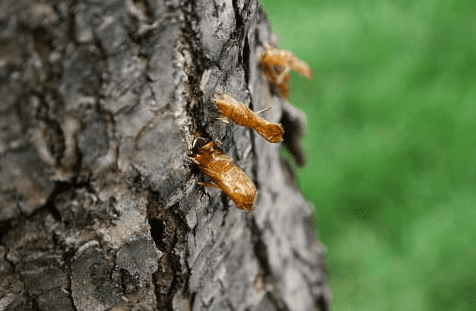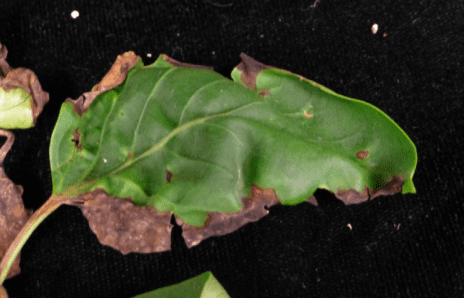A blooming lilac tree is one of the most beautiful sights in springtime. That’s why I was so dismayed to find holes in my tree a few years ago. I thought something was wrong with the tree, but it turns out that the holes were made by a type of beetle called lilac borer.
In this post, I’ll share what I’ve learned about holes in lilac trees and how to control the borers that are usually to blame. I hope you find this information helpful if you have a lilac tree of your own!
Why Are There Holes in My Lilac Tree?
Lilac borers are the most common culprit behind holes in lilac trees. These are wasp-like moths that emerge in the spring and then lay their eggs on the bark of the tree. The larvae hatch and burrow into the tree, where they feed on the sapwood for several months. This feeding can cause extensive damage to the tree and eventually results in holes in the bark.
The Lilac Borer is also known as the Ash Borer as it attacks other trees in the ash family such as Mountain Ash and Green Ash. It is a common problem for many trees in the US. In fact, the pest is to blame for a lack of lilacs in many areas of the country.
If you think your tree might have lilac borers, it’s important to take action quickly. These pests can cause serious damage to trees, and infestations can spread quickly if not controlled.
How to Remove Lilac Borer from Lilac Tree?
Getting rid of lilac borers can be tricky. In fact, if the pest is already established in your tree, it’s likely that the damage has already been done. However, you may be able to stop them if you act fast enough. Here’s my step-by-step guide to removing Lilac Borers:
The first step is to remove any infested branches with a pair of powerful pruners. Cut the branches off close to the trunk of the tree and dispose of them immediately. This will help to prevent the spread of pests.
Position pheromone traps around the trees to capture male borers. These can be found at most garden stores or online. Capturing male Lilac Borers stops any further reproduction and will eventually help to reduce the population.
Apply an insecticide to the tree trunk. You may need a lot of it, so try using an economical option that is easy to source and doesn’t cost too much. Neem oil is a good one to try. Reapply the insecticide every few weeks to keep the borers at bay. You may need to do this for several months, but it’s important to be consistent in order to protect your tree.

How to Keep Lilac Borers Away from Lilac Tree?
Without a doubt, the best way to keep Lilac Borers away is to practice preventative care. This means keeping your tree healthy and strong so that it can better resist attack. Here are some tips for preventing lilac borer infestation:
1. Pheromone Traps
From April until the end of May, place pheromone traps around the base of your tree. These will help to catch any male borers before they have a chance to mate and lay eggs. This is my number one recommendation for preventing an infestation.
2. Mulch
You may unwittingly be inviting borers into your trees when you cut the trunk with lawn equipment, so protect the base of your tree by applying a layer of mulch. This will also help to keep the area around the tree clean and free from debris where borers could lay their eggs.
3. Prune Often
Prune your tree regularly to remove any dead or dying branches. This will help to keep the tree healthy and also make it less attractive to borers. You see, this pest is often drawn to weak or sickly trees.
4. Inspect Regularly
Make it a habit to inspect your tree regularly for any signs of damage. This way you can catch an infestation early and take steps to control it before it gets out of hand. Noticing Lilac Borers once they have already started to damage your tree is usually too late.
What Else Causes These Holes?
Lilac Borers aren’t the only pests that can cause holes in both your tree and the leaves. If you notice any damage, it’s always best to have a professional take a look to confirm what is causing it. Other common culprits include:
Animals – Animals such as squirrels, mice, birds, and rabbits can all cause damage to trees. They often gnaw on the bark, which can lead to holes in the trunk. For example, woodpeckers will drill holes in trees in search of food.
Harsh Weather – Harsh weather conditions such as high winds and heavy snow can also cause damage to trees. This is often seen in the form of broken branches or split trunks. Hail can be so powerful that it bursts through leaves, leaving behind small holes.
Disease – There are several diseases that can cause damage to lilac trees. For example, bacterial blight can cause brown spots on the leaves, while powdery mildew can lead to white powdery patches on the leaves and stems. Both of these diseases can spread quickly and cause significant damage if left unchecked.

Should I Prune Lilac Tree Leaves with Holes?
When lilac tree leaves are damaged, I first find out what has caused the damage. Once you have identified the problem, you can take steps to control it and prevent further damage.
Leaves that are affected by a fungal disease should be pruned and destroyed to prevent the spread of infection. If the holes were caused by animals or pests, there is no need to prune the leaves. The tree will eventually grow new leaves to replace the damaged ones.
Pruning is only necessary if the damage is severe and affects a large portion of the tree. Otherwise, it’s best to leave the tree alone and allow it to heal itself.
Conclusion
In conclusion, holes in lilac trees are most often caused by lilac borers. These moths lay their eggs on the bark of the tree, and when the larvae hatch, they burrow into the wood to feed. This can cause extensive damage to the tree and eventually kill it if left unchecked.
It’s worth stressing that the best way to prevent lilac borer damage is to practice preventative care. This means using pheromone traps, mulching, pruning often, and inspecting regularly.
If you notice any damage on your tree, it’s always best to have a professional take a look. They will be able to confirm what is causing the damage and recommend the best course of action.
Have you ever had to deal with lilac borers or other pests damaging your tree? Let me know in the comments below! Thanks for reading!
Tim is an avid gardener from the UK. He was the founder of PlantCarer.com from 2021 to Sep 2023. He sold PlantCarer.com to Aaron. He has since started his own business called Seed To Supper, which provides new gardeners all the materials you need in a box (pots, seeds, compost and instructions) to grow your own delicious and nutritious vegetables and herbs from start to finish – no garden required.









0 Comments